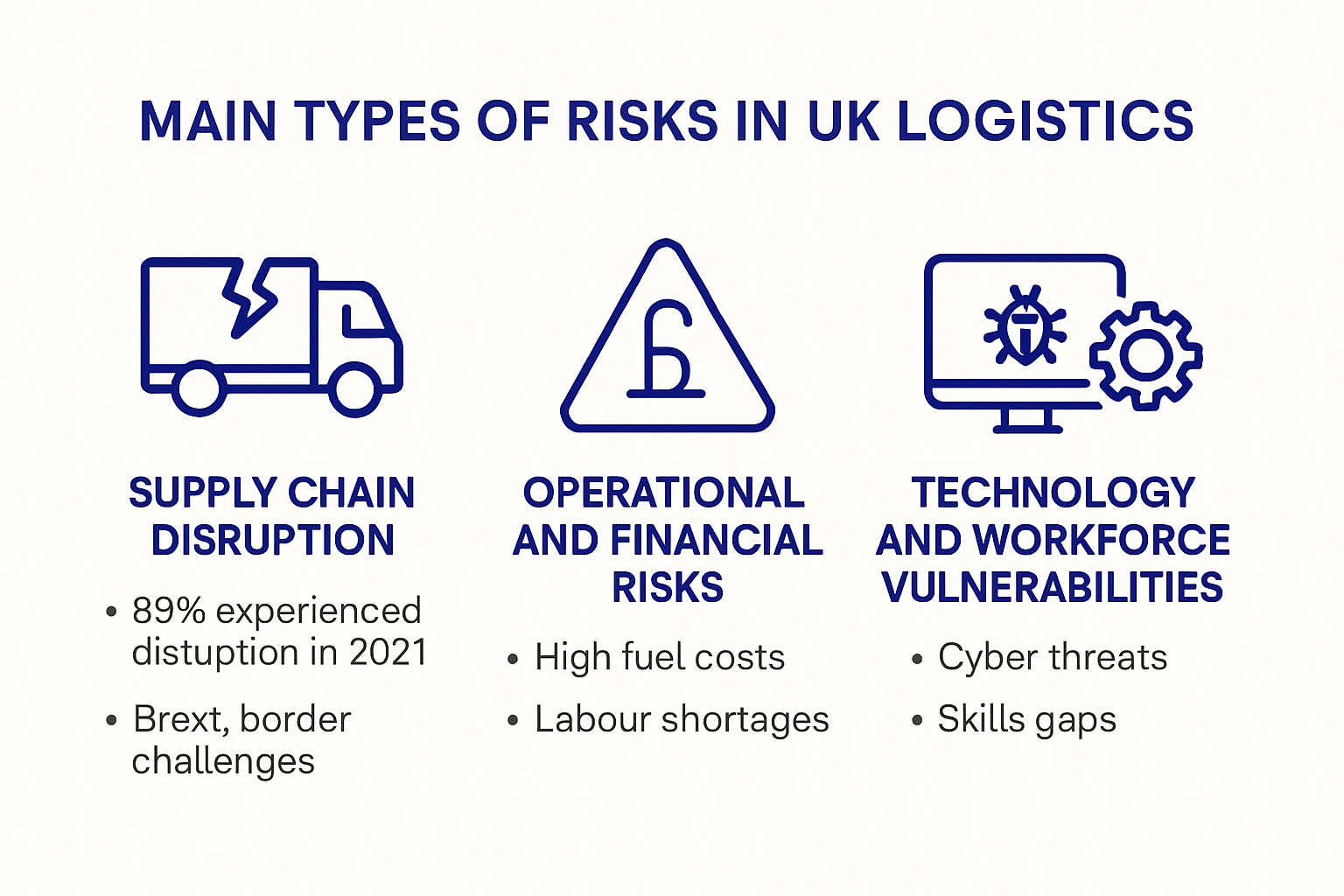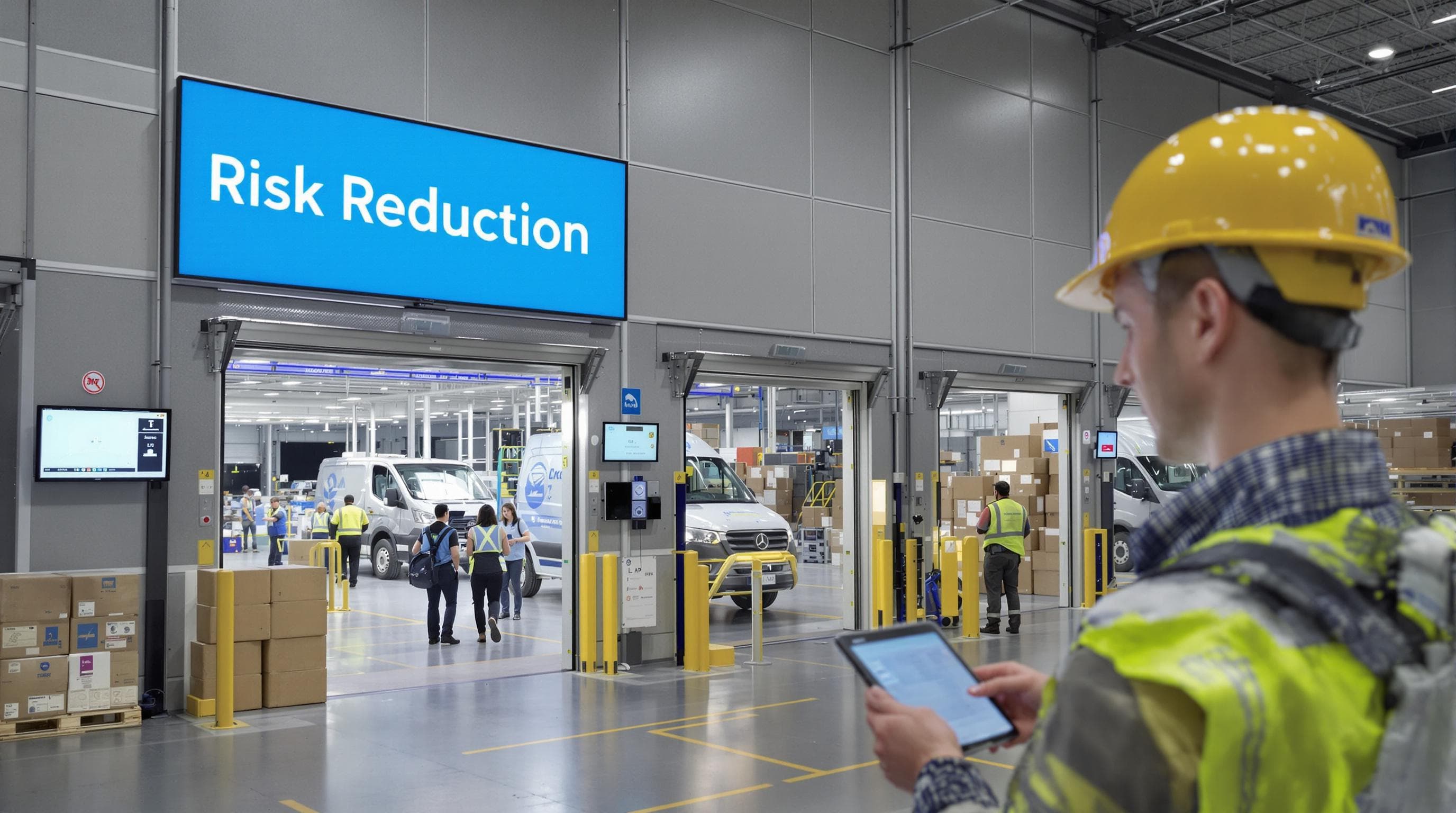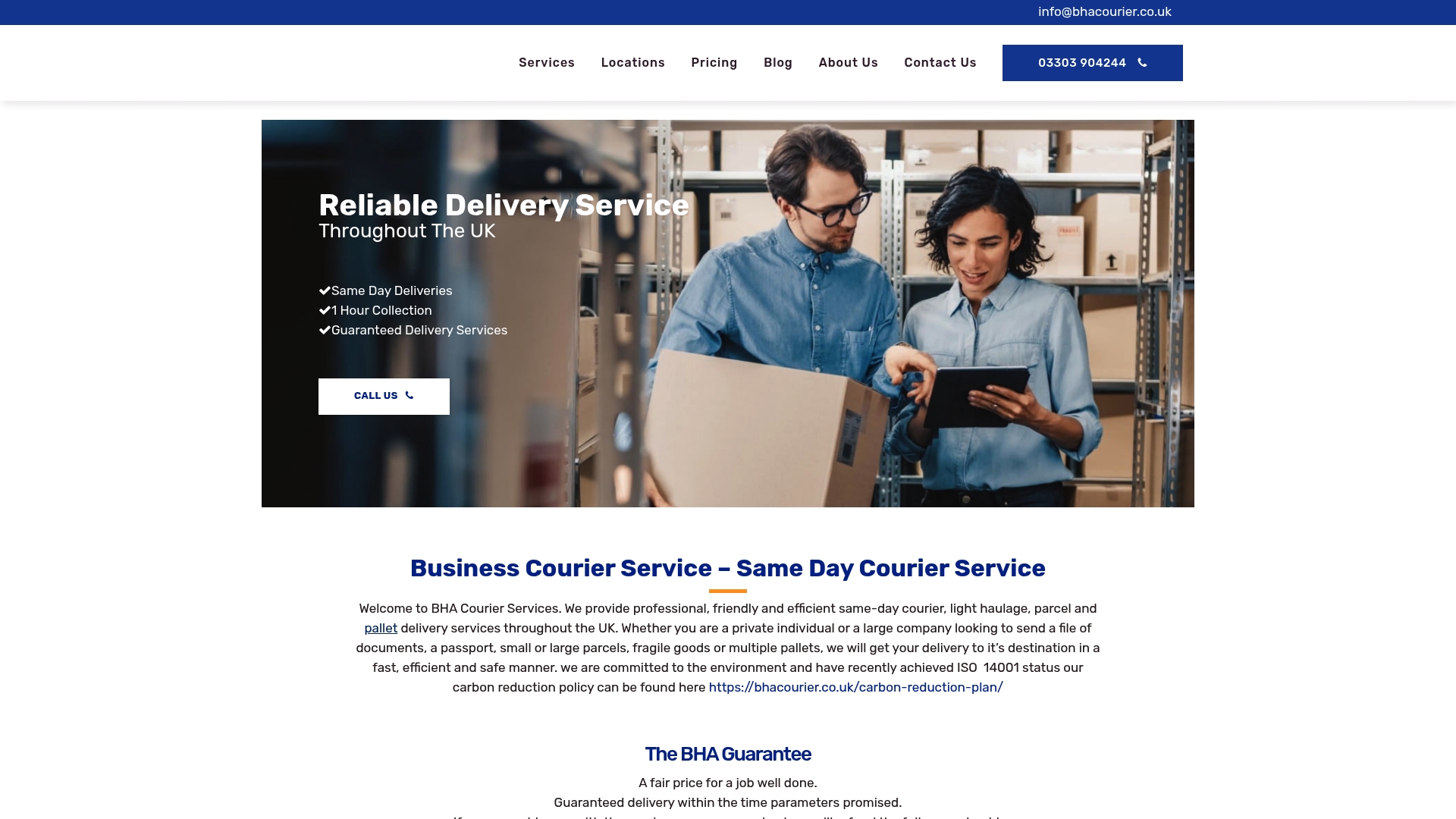
21 Jul Risk Management in Logistics: Essential Strategies for UK Businesses 2025
UK businesses are facing a new wave of uncertainty as logistics risks multiply. Supply chain troubles, extreme weather, and cyber attacks are keeping decision-makers awake at night. Yet, despite all the headlines, few realise that 73% of British firms suffered at least one supply chain disruption during the pandemic. The real surprise? Most are still overlooking the power of simple strategies and cutting-edge tech that could safeguard them for 2025 and beyond.
Table of Contents
- Common Risks Faced In UK Logistics
- Key Strategies For Managing Logistics Risks
- Tools And Technology For Risk Reduction
- Best Practices For Small And Medium Businesses
Quick Summary
| Takeaway | Explanation |
|---|---|
| Supply Chain Vulnerabilities Require Robust Strategies | 73% of businesses experienced disruptions during the pandemic, highlighting the need for strong risk management practices to address supply chain disruption risks such as geopolitical instability, climate change impacts, and technological vulnerabilities. |
| Adopt Technology-Driven Risk Mitigation | Embrace advanced digital tools such as real-time tracking systems, predictive analytics, and robust cybersecurity frameworks to anticipate and respond effectively to logistics risks. |
| Prioritise Workforce Development | Continuous training and the establishment of cross-functional risk teams are essential to enhance your organisation’s capacity to identify, assess, and manage risks effectively. |
| Implement Strategic Resource Allocation | SMEs should focus on targeted risk assessments and phased investments in risk management technologies to optimise resource use and enhance operational resilience. |
| Enhance Supply Chain Resilience Through Diversification | Develop multiple supplier relationships and create flexible transportation options to reduce dependency risks and maintain operational capability during disruptions. |
Common Risks Faced in UK Logistics
Risk management in logistics represents a critical challenge for UK businesses navigating an increasingly complex operational environment. The logistics sector faces multifaceted risks that can significantly impact business performance, profitability, and reputation.
Supply Chain Disruption Risks
Supply chain vulnerabilities have become more pronounced in recent years, with global events highlighting the fragility of interconnected logistics networks. Research from McKinsey indicates that 73% of businesses experienced supply chain disruptions during the pandemic, underscoring the need for robust risk management strategies.
Key supply chain disruption risks include:
- Geopolitical Instability: International tensions and trade conflicts can interrupt material flows and transportation routes.
- Climate Change Impact: Extreme weather events increasingly threaten transportation infrastructure and delivery networks.
- Technological Vulnerabilities: Cybersecurity threats and digital system failures pose significant operational risks.

Operational and Financial Risks
Logistics businesses must contend with complex operational challenges that can quickly translate into financial vulnerabilities. PwC’s Global Risk Survey highlights that transportation and logistics companies face unique risk profiles involving asset management, regulatory compliance, and economic fluctuations.
Critical operational risks include:
- Transportation Asset Risks: Vehicle maintenance, fuel price volatility, and equipment depreciation represent substantial financial challenges.
- Compliance and Regulatory Changes: Evolving legal frameworks, particularly post Brexit, create additional complexity for UK logistics providers.
- Insurance and Liability Concerns: Our comprehensive guide on courier insurance explores the critical protection mechanisms businesses must implement.
Technology and Workforce Risks
The rapid digital transformation of logistics introduces both opportunities and significant risks. Emerging technologies like artificial intelligence, automation, and advanced tracking systems offer efficiency gains but simultaneously create new vulnerability points.
Workforce risks encompass:
- Skills Gap: The increasing technological complexity requires continuous workforce upskilling and training.
- Recruitment Challenges: Logistics sectors face ongoing difficulties in attracting and retaining skilled professionals.
- Cybersecurity Vulnerabilities: Digital systems managing logistics operations are increasingly targets for sophisticated cyber attacks.
Successful risk management in logistics demands a proactive, comprehensive approach that anticipates potential disruptions, implements robust mitigation strategies, and maintains organisational flexibility. UK businesses must develop adaptive frameworks that can quickly respond to emerging challenges while maintaining operational continuity and competitive advantage.
To help visualise the main categories and examples of risk described in this section, the following table summarises these common risks faced in UK logistics and provides representative examples for each.
| Risk Category | Examples |
|---|---|
| Supply Chain Disruption Risks | Geopolitical instability, climate change impact, technological vulnerabilities |
| Operational and Financial Risks | Transportation asset issues, compliance changes, insurance and liability concerns |
| Technology and Workforce Risks | Skills gap, recruitment challenges, cybersecurity vulnerabilities |
Key Strategies for Managing Logistics Risks
Navigating the complex landscape of logistics risk requires strategic, proactive approaches that anticipate potential challenges and develop robust mitigation frameworks. Successful risk management demands comprehensive strategies that address technological, operational, and human factors.
Technology-Driven Risk Mitigation
Research from Purdue University emphasises the critical role of technological solutions in managing logistics risks. Advanced digital tools now enable businesses to implement sophisticated risk monitoring and response mechanisms.
Key technological strategies include:
- Real-Time Tracking Systems: Implementing GPS and IoT technologies to monitor shipments, vehicles, and inventory in real-time.
- Predictive Analytics: Utilising machine learning algorithms to forecast potential disruptions and recommend preemptive actions.
- Cybersecurity Protocols: Developing robust digital security frameworks to protect sensitive logistics data and operational systems.
Supply Chain Resilience and Diversification
Thomson Reuters highlights that strategic diversification represents a fundamental approach to risk management. Businesses must move beyond traditional linear supply chain models towards more adaptive, flexible networks.
Critical diversification strategies encompass:
- Supplier Portfolio Management: Developing multiple supplier relationships across different geographical regions to reduce dependency risks.
- Flexible Transportation Options: Creating alternative routing and transportation mechanisms to ensure continuous operational capability.
- Inventory Buffer Strategies: Maintaining strategic inventory reserves to mitigate potential supply chain interruptions.
Comprehensive Risk Assessment and Training
Effective risk management extends beyond technological solutions, requiring a holistic approach that integrates human expertise and organisational culture. Our comprehensive insurance guide provides deeper insights into protective mechanisms for logistics operations.
Essential human-centric risk management approaches include:
- Continuous Skills Development: Implementing ongoing training programmes to enhance workforce capabilities in risk identification and response.
- Cross-Functional Risk Teams: Creating dedicated internal teams responsible for monitoring, assessing, and developing risk mitigation strategies.
- Regular Risk Audits: Conducting periodic comprehensive assessments of operational vulnerabilities and developing adaptive response protocols.
Successful risk management in logistics requires an integrated approach that combines technological innovation, strategic diversification, and continuous organisational learning. UK businesses must develop flexible, proactive frameworks that can rapidly adapt to emerging challenges while maintaining operational efficiency and competitive advantage.
Tools and Technology for Risk Reduction

In the rapidly evolving logistics landscape, technological innovations have become paramount in mitigating operational risks and enhancing organisational resilience. Modern businesses increasingly rely on sophisticated digital tools to predict, monitor, and manage potential disruptions across their supply chains.
Artificial Intelligence and Predictive Analytics
Research from Fraunhofer IML demonstrates the transformative potential of artificial intelligence in logistics risk management. Advanced machine learning models enable businesses to develop more sophisticated risk assessment frameworks.
Key AI-driven risk reduction strategies include:
- Predictive Forecasting: Utilising machine learning algorithms to anticipate potential supply chain disruptions.
- Anomaly Detection: Implementing intelligent systems that can identify unusual patterns in logistics operations.
- Dynamic Risk Scoring: Creating adaptive risk assessment models that continuously update based on real-time data inputs.
IoT and Real-Time Monitoring Technologies
A systematic literature review highlights the critical role of Internet of Things (IoT) technologies in modern risk management strategies. Connected sensor networks provide unprecedented visibility into logistics operations, enabling proactive risk mitigation.
Critical IoT applications in risk reduction encompass:
- Asset Tracking: Implementing GPS and sensor technologies to monitor shipment conditions and location in real-time.
- Environmental Monitoring: Using advanced sensors to track temperature, humidity, and other critical parameters during transportation.
- Predictive Maintenance: Leveraging sensor data to predict potential equipment failures before they occur.
Blockchain and Advanced Data Integration
Research published in Discover Sustainability explores the emerging potential of blockchain technologies in enhancing logistics transparency and risk management. These advanced digital platforms offer unprecedented capabilities for secure, transparent data sharing across complex supply networks.
Blockchain and data integration strategies include:
- Transparent Supply Chain Tracking: Creating immutable records of logistics transactions and movements.
- Smart Contract Implementation: Developing automated risk management protocols that trigger specific actions based on predefined conditions.
- Multi-Party Risk Collaboration: Establishing secure platforms for sharing risk-related information across organisational boundaries.
The integration of these advanced technologies represents more than a technical upgrade. It signifies a fundamental transformation in how UK businesses approach risk management in logistics. By embracing intelligent, data-driven solutions, organisations can develop more resilient, adaptive operational frameworks that can quickly respond to emerging challenges.
Successful technological risk reduction demands continuous investment in skills development, robust cybersecurity protocols, and a culture of innovation. UK logistics businesses must view these technologies not as standalone solutions, but as interconnected components of a comprehensive risk management strategy.
The following table provides a comparison of the main technology solutions discussed, highlighting their specific applications in reducing logistics risk.
| Technology | Primary Application | Key Risk Reduction Feature |
|---|---|---|
| Artificial Intelligence (AI) | Predictive forecasting, anomaly detection | Anticipates and identifies disruptions |
| IoT (Internet of Things) | Asset and environmental monitoring | Real-time operation insight |
| Blockchain | Data integration and tracking | Ensures supply chain transparency |
Best Practices for Small and Medium Businesses
Small and medium enterprises (SMEs) in the UK logistics sector face unique challenges in implementing robust risk management strategies. Unlike large corporations, these businesses often operate with limited resources and must develop smart, cost-effective approaches to mitigating potential operational risks.
Strategic Resource Allocation
Research from the Federation of Small Businesses emphasises the importance of strategic resource allocation for effective risk management. SMEs must prioritise their risk mitigation efforts to maximise limited financial and operational capabilities.
Key strategic approaches include:
- Targeted Risk Assessment: Conducting comprehensive yet focused risk evaluations that identify the most critical vulnerabilities.
- Phased Investment: Implementing risk management technologies and strategies incrementally to spread financial burden.
- Collaborative Risk Sharing: Developing partnerships with other businesses to share risk management resources and expertise.
Technology and Insurance Optimisation
Our comprehensive courier insurance guide provides critical insights into protecting logistics operations. Small businesses can leverage affordable technological solutions and targeted insurance products to enhance their risk management capabilities.
Practical technology and insurance strategies include:
- Cloud-Based Risk Management Tools: Utilising affordable, scalable digital platforms for tracking and managing operational risks.
- Modular Insurance Solutions: Selecting flexible insurance products that can be customised to specific business needs.
- Cybersecurity Fundamentals: Implementing basic digital protection measures that do not require significant financial investment.
Workforce Development and Cultural Adaptation
The Chartered Institute of Logistics and Transport UK highlights the critical role of workforce capabilities in effective risk management. SMEs must focus on developing a risk-aware organisational culture that empowers employees to identify and respond to potential challenges.
Workforce development strategies include:
- Continuous Training Programmes: Creating accessible, affordable training modules that enhance risk awareness and response capabilities.
- Cross-Functional Risk Teams: Developing internal teams that can identify and address potential risks across different operational areas.
- Open Communication Channels: Establishing transparent reporting mechanisms that encourage employees to share potential risk insights.
Successful risk management for small and medium logistics businesses requires a holistic, adaptive approach. By combining strategic resource allocation, targeted technological investments, and a strong organisational culture of risk awareness, UK SMEs can develop resilient operational frameworks that protect their business interests.
The most effective risk management strategies are not about eliminating all potential risks, but about building organisational capabilities to anticipate, respond, and recover from unexpected challenges. Small businesses that embrace this philosophy can transform risk management from a potential burden into a competitive advantage.
Frequently Asked Questions
What are the common risks faced in UK logistics?
Common risks in UK logistics include supply chain disruption risks caused by geopolitical instability and climate change, operational and financial risks like asset management and compliance issues, and technology-related risks such as cybersecurity vulnerabilities and skills gaps within the workforce.
How can UK businesses mitigate logistics risks?
UK businesses can mitigate logistics risks by adopting technology-driven solutions such as real-time tracking systems and predictive analytics, diversifying their supply chains, conducting comprehensive risk assessments, and investing in continuous workforce training.
What role does technology play in logistics risk management?
Technology plays a crucial role in logistics risk management by enabling real-time monitoring, enhancing predictive capabilities via AI, and ensuring data integrity through blockchain, thereby allowing businesses to respond promptly to potential disruptions.
What are the best practices for small and medium businesses in logistics risk management?
Best practices for SMEs in logistics risk management include strategic resource allocation to prioritise risk efforts, leveraging affordable technology and modular insurance solutions, and fostering a culture of risk awareness through continuous workforce development and open communication.
Turn Risk into Opportunity with Smart Courier Solutions
Is uncertainty in your logistics operation causing sleepless nights? As highlighted in our analysis of risk management for UK businesses, threats like supply chain disruptions, technology vulnerabilities, and compliance challenges are now more complex than ever. You want to avoid delays, safeguard fragile or time-sensitive items, and be confident that your deliveries remain secure even during unexpected events. These are goals shared by many UK firms striving for resilience in 2025.

BHA Courier understands what is at stake. We specialise in time-critical and secure courier services designed to reduce operational risks and increase supply chain flexibility. Our same-day and guaranteed next-day deliveries ensure your parcels, documents, and goods reach their destination safely and precisely when needed. With a nationwide network, eco-friendly operations, and advanced parcel tracking, you are empowered to respond quickly to unforeseen logistical challenges.
Why wait and risk potential losses or unhappy customers? See how our rapid-response courier services can help you build a resilient supply chain. Visit BHA Courier to explore bespoke solutions and get started on securing your delivery operations today.

Sorry, the comment form is closed at this time.